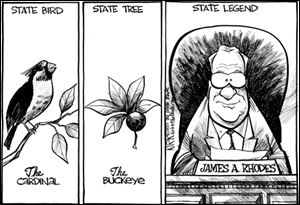
Ingenuity a key to summer fun
3/6/2001
A hundred bucks for a scooter?
The emergent popularity of those shiny and streamlined two-wheelers, the newest got-to-have-it craze for youngsters, takes me back, way back, to the days when scooters didn't cost much of anything.
Most times, they cost nothing because you made them out of whatever was lying around the yard or stacked up in a corner of your dad's garage. The main items needed were some wood, an old pair of roller skates, a hammer and saw, and some nails.
Living in a small southern town in the middle of the Depression Thirties, my friends and I had to make do with what we had. I became an expert on scooters, building them for myself, some smaller neighbor kids, my sister, and just about anyone who wanted one.
We used to race them around the streets in my Arkansas hometown. On warm summer evenings, we'd push our scooters to the top of McDonough Street Hill and race each other down the three-block course. Cars? There weren't many back then, and most of them were parked or garaged by early evening.
We also scooted downtown through the alley paralleling Cherry Street, the main drag. The police wouldn't allow our homemade devices on the main street. We also used the scooters to go over the levee and fish in Otter's Pond, near the Mississippi River.
Building a scooter wasn't all that hard. All you needed was an old pair of roller skates. There were a lot of those around the neighborhood; either bent or in two parts because of a lost skate key. The key allowed the skates to be shortened or lengthened depending on the wearer. If you lost the key, you were out of luck and through skating.
After finding the skates, you separated the front and rear halves, each end containing a set of ball-bearing wheels. You then took an acceptable piece of lumber, usually a two-by-four, and nailed the two sets of wheels on each end.
A shorter two-by-four was nailed on one end, and formed the base of the steering column. A shorter piece of wood, or sometimes a discarded bike handlebar, would then be nailed on top of the base.
The base would not stand up without being braced, and this required sawing two thinner pieces of wood and bracing the scooter base to the footboard.
This sometimes allowed creative license, since the braces could be covered with another section of wood, forming a triangular storage spot for slingshots, gum, candy, fishbait, hooks, and line.
Brakes? Kids with shoes dragged one foot on the pavement. Those without shoes rigged up a small chunk of wood held to the side of the footboard with a single nail. When the piece of wood wore down, it was replaced with a new piece.
Steering was done by leaning in the direction you wanted to go, but I found that by not nailing the lead skate wheels solidly to the footboard, you could steer easier and make sharper turns.
Some scooters were painted, usually in whatever paint was stored in the garage. All I had was some ancient green paint my dad used to paint his boat. It was old, and after it dried, my scooter resembled an anemic camouflaged L.
My scooter career ended after a couple of summers when I appropriated a skate from what I thought was a pair that my neighbor, Martha Ann Perry, had discarded. She hadn't. The skates were new, and I had to dismantle my scooter, buy a new skate key, and reassemble them while Martha Ann glowered at me.
I spent the rest of the scooter season watching races from the curb on McDonough Street Hill.
Hank Harvey is a retired Blade staff writer.